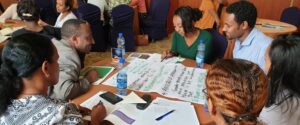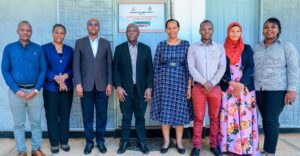Why we need to take a collective action approach to research capacity building
Sometimes it feels hard to keep afloat in the tide of thinking and debate about development – what to do, how to do it better – and difficult to find time to take the latest thinking and actually incorporate it into programme design. Harder still to incorprate the latest thinking into projects that are already in progress.
It’s a couple of years since David Booth and Diana Cammack published their book on governance in Africa (there’s a nice summary here). They argue that development is about solving collective action problems. But the key idea – that problems can only be tackled by ditching the supply/demand focus, and by bringing different groups together and finding a common ground – stuck, because it made so much sense and resonated with much of what we’ve learnt at INASP over the years. As they argue:
‘…governance challenges are not fundamentally about one set of people getting another set of people to behave better. They are about both sets of people finding ways of being able to act collectively in their own best interests. They are about collective problem-solving in fragmented societies hampered by low levels of trust.’
In Booth and Cammack’s book, these are questions being addressed to big public service delivery problems – like delivering maternal health services – but they’re worth asking of our work too.
There are many projects tackling research capacity – and the use of research for policy or practice – in different ways. Many initiatives take one aspect, or one group of actors, and provide support to enable them to solve their piece of the puzzle. But usually their ability to achieve some form of positive change is dependent on a number of other groups. Sometimes the focus is on the supply of research (producing new research, accessing research that others have produced), and sometimes the focus is on demand (encouraging those who have a use for research to seek it out). But even within a ‘supply-side’ initiative (say, accessing existing research and drawing on that to produce new research), there are ‘demand’ elements too.
Access to research
To take a problem that’s been core to INASP’s work for 20 years: Southern researchers don’t have access to the journals and books they need.
The problem is commonly tackled by working with those who provide this access: librarians. But their success is typically dependent, to a greater or lesser extent, on a whole range of others who are responsible for doing research, setting policy, providing funding, teaching and supervising students and junior researchers, and managing IT infrastructure. These include university management and leadership, heads of research, IT directors, research councils, higher education commissions and national IT infrastructure organizations.
If librarians provide access to journals, but there’s not sufficient attention to the demand (or need) by researchers and students, then they might supply the wrong journals, or the journals might not get used. Low use then makes it hard to justify future funding.
Or if the emphasis is on purchasing journals, but no attention is given to the IT infrastructure, poor internet connections and IT networks could make them hard to access and use in practice. Or if those who set budgets and agree staffing levels don’t appreciate all the ‘back office’ work to enable access (negotiating good licences, registering IP addresses, setting up search systems – it’s not just all on Google now!) they may not allocate sufficient funding or staff.
Access works, but use is low
We and our partners – and other initiatives working alongside us like EIFL and Research4Life – have made fantastic strides here. There are now thousands of the latest journals (and their back collections) available. But usage stats often suggest they aren’t used as much as we might expect.
One way to look at this is by checking the breaks in the chain – are internet connections and IT facilities sufficient? Do people know how to search effectively?
But there’s a bigger question too: is there much research taking place? And is the type of research (‘academic’ vs ‘consultancy’) likely to lead to journals being used? In short, what is the real demand?
Collective approaches
Fixing these isn’t within the scope of a single person or department. And it isn’t even always because we don’t know how to solve the problem; it’s that the ‘right’ solutions don’t seem to work in practice.
It requires the cooperation of several different groups within and beyond universities and research institutes. And it’s not a simple case of one group (in this case, librarians) trying to get another group (say, IT staff) to ‘fix’ their bit of the chain, or telling another group (say, researchers) what is available. It’s about understanding what each group is trying to achieve, and how and where these aims align. It also means thinking about incentives and motivations.
Is there even a reason for one group to work with another in pursuit of a solution? Are staff motivated to tackle problems, or is morale low and even the right solutions won’t be pursued with any vigour?
So what does this suggest for INASP? Well, we have a great wealth of training materials for librarians, IT staff and researchers, and a lot is being achieved by developing skills. But we also need to go that step further and think about unlocking the potential of the collective to solve the problem. This is something we’re starting to do more of – so this is very much a first reflection, toe-in-the-water post to invite some comments and ideas.
Establishing access to research as a collective endeavour in Sierra Leone
We’ve blogged before about our work in Sierra Leone (and see here for a more detailed review). The starting point for this project was improving access to research information – beginning with making use of what was already available to researchers in Sierra Leone via Research4Life.
From the start we approached this as a collective action problem (although not consciously using that language). We started by convening key people from across the two principal universities (USL and Njala) to talk about their ambitions for developing research (logistical problems mean it ended up being two separate events). This helped not only to discuss the parameters of the project, but helped to establish it as a collective endeavour. It wasn’t just going to be the responsibility of librarians to ‘fix’ this, but also of deans of faculties, IT directors and the university’s senior leadership. It was evident that researchers wanted to get more of their work visible and published, and so any conversation about access would go further if we could help address this side too – greater skills to publish (and greater chance of getting published) would probably do more to stimulate use than lots of training in how to access journals.
Unsurprisingly, the Ebola outbreak stalled the project pretty quickly, but even then we were able to provide an e-learning course (downloaded, so it didn’t need a live internet connection) to researchers at Njala University on developing and communicating research.
Working together in Ghana
In Ghana, the Consortium of Academic and Research Libraries (CARLIGH) felt that the research communication system wasn’t as effective as it could be. So we worked with them to develop a process where key stakeholders would come together to tackle this as a shared challenge. Step one was to understand the system in Ghana better, so CARLIGH and INASP produced a briefing document to inform the process. CARLIGH decided to begin by bringing together representatives of three of the leading research centres in the country – the Council for Scientific and Industrial Research (CSIR), the Ghana Atomic Energy Commission and Noguchi Memorial Institute for Medical Research – with IT and library leaders. We’ve got a bit more work to do to get the approach right, but the feedback was good, and those involved seemed to value the chance to get together and think through some shared problems. The plan is to develop this in other countries now – and, of course, to check back in with our Ghanaian partners and see what they’ve been able to achieve as a result.
Tackling some even bigger questions
INASP’s work goes far beyond access to research. The bigger questions are about how to strengthen the overall research and knowledge system in a country. Access is part of this, but for research to contribute to policy making, or to the more practical aspects of programme design and service delivery, we obviously need to bring users into this collective conversation too. We’re currently working with policy makers in Ghana and Zimbabwe, to stimulate greater demand for research evidence, and to enable them to appraise and deploy it more effectively. But we’re not yet bringing all of these groups into conversation together.
Convening conversations at this system level – bringing together all those with a stake in doing, communicating and using research – is something we’re actively thinking about. So if you’d be interested in working with us on this let us know, particularly if you work in a research or policy institution in Africa or Asia and think there would be potential in such an approach in your country.





This post is a lot easier to read than what the title suggests 🙂
A collective action approach is also perhaps needed in the publishing world.
1. Researchers are under pressure to publish or perish. Publications are often the end goal. Publish somewhere, move on.
2. Journals and publishers are caught up in debates over traditional vs open access publishing, use and misuse of the impact factor, etc.
3. Librarians are busy with licensing of journal collections, negotiations with publishers, etc.
4. Policymakers – well, I don’t know much about how they work, but I imagine that they need relevant research information presented in a form that is actionable. I’ve rarely heard researchers or journal editors (two groups I’m familiar with) mention policymakers, or for that matter librarians.
As far as I know, these groups are not talking to each other enough to arrive at a shared understanding and work from there towards goals at a societal level. There are numerous associations for any single group, but is there any platform where they are all somewhat equally represented?
Hi Ravi, point well taken about clarity and choice of words! I deliberately chose that title in an attempt to fit it into some broader debates going on in development, and particularly in the governance/politics area which I tend to follow. But I can see that while the title might work for some, it probably doesn’t for others!
There are obviously several things to be fixed in the current system of academic publishing (or perhaps the communication of research, to broaden the scope). I won’t go into that here, because they’re pretty well debated. I tend to follow Vanessa’s thinking about a new group or platform (which I assume you had in mind as an international or at least large scale platform?) – that new groups can be hard to maintain (time, money). Perhaps the solution here lies in smaller scale initiatives to change things in particular sub-sectors, and temporary or shifting coalitions around a problem, rather than a formal platform or group. On the disciplinary approach, people who know more about this than I do seem to point to the physics community here (ArchivX, SCOAP3). I can’t claim any expertise here in how to ‘do’ collective problem solving – these are ideas I’m playing with really to see if we can find some new and better ways to support change – but I think the starting point probably has to be the problem – so what problem to different groups broadly agree on (they have different views on how to tackle it, but agree it’s a problem) and work from there. This might work at a disciplinary or thematic level, or at a national level. Perhaps starting small, and doing so in multiple places, could help to come up with some new solutions, which can be tested, and (if successful) demonstrate the possibility of alternative routes to other disciplines/research clusters/countries.
To the question of ‘why we need to take a collective approach to research capacity building,’ I see one of the answers as also being to try to ensure sustainability of the work that we do. Sustainability is a key component of INASP’s work and takes several forms. For instance, we are currently working to embed training courses in partner institutions, anticipating that these courses will continue to run and be of benefit – bringing about positive change – long after INASP has been involved. I can see that working at system level – convening conversations and bringing different actors together to solve a common problem – could well be an approach that contributes to the sustainability of the changes that we are supporting. If a problem has been identified and solved collectively for the benefit of all those with a stake in the issue, surely this solution would be championed, acted upon, maintained and re-visited as necessary to make sure that the initial problem never resurfaces. It will be interesting to see if such a collective approach does indeed influence the sustainability of solutions.
Thanks Fran. So by extension, we’re less likely to achieve sustainability if we’ve not started with a shared understanding of the problem we’re trying to solve. I think it’s actually quite easy for that to happen. For example, if some of those involved were interested more on the ‘thing’ being provided now, and not what happens to it in the future, then they might be concentrating their efforts on what the former requires (to provide it now), but not worrying about the elements of the project which are designed to address the latter (to provide it in the future). It’d also suggest that some type of ‘convening’ would be needed at regular intervals – throughout the project to keep things on track, but also post-project, when it’s ’embedded’. Perhaps some form of oversight group drawing together representatives of different groups with an interest in the ‘thing’ continuing?
Thaks for sharing all these relevant reflections, Jon. I also think that this field is so complex that it demands more systemic approaches to help the dots better link and connect. I have been following progress of the Collective Impact Forum for a while now (see http://collectiveimpactforum.org/resources/practitioner-insights-why-collective-impact) since I am convinced on the need to work differently and tap into a pool of people with different roles to enable sustainabe change.
Conversations seem to be the first very natural step: we need to understand with those who play a role where the potential collaboration resides (by identifying areas of common interests and some capacity to work with others) as well as where obstacles appear (conflicting visions/ideas, very different ways of working, including methods, timing, etc.). The idea of weaving new networks is very appealing but transactional costs are high and results usually take a longer time so it´s also a challenge in terms of demonstrating impact to donors.
Here in the South (at P&I we work mostly with people from developing countries) we do not have access to long-term funding that would allow us to both stay focused and allow enough time for deeper agreements, trust building, etc. Our project-based type of work does not enable forging the type of partnerships we need to forge: without a longer term horizon policymakers, researchers and others get very enthusiastic on what we do but iin a very ad hoc basis, related to specific activities. I think that what Ravi mentions in terms of a common platform is true, but who would build and nurture such a platform until is mature enough to keep going on by itself? If INASP has the resources and timeframe to try out this type of approaches I believe you should go for it!
Thanks Vanessa, that looks like a useful initiative. I’ll have a good look through the site. I think you’re absolutely right about starting with a conversation. As you say the challenge is how to sustain that – I agree that creating new networks isn’t necessarily the way forward. You mentioned tapping into a pool of people with different roles. What kind of people or roles did you have in mind?
Duncan Green has just published a post on collective action, based on a new briefing by the Developmental Leadership Programme. It’s interesting because it identifies two types of collective action problem.
Type A: ‘Coordination: Collective action problems tend to persist because the efficient coordination of many group members is difficult. For example, a vibrant, highly participatory democracy is viewed as a collective benefit, especially from a Northern perspective. However, civil society groups can face significant coordination challenges when trying to mobilise citizens to vote.’
Type B: ‘Diverging interests: Some citizens may decide it is in their interest to act in concert for the collective good, while others may not. If only a few of the potential actors mobilise, the collective good may not materialise to its full potential.’
This suggests we need to be a bit clearer about types. Some of the scenarios above (the access/use of journals) feel more like type A problems, but others are undoubtedly the more political type Bs. This would suggest some quite different responses – a scenario where everyone is pulling in different directions probably isn’t going to be improved by a convening exercise (there won’t be some kind of eureka moment where everyone realises how they can all work together to improve things!) so those power issues will need to be understood and reflected in the design of an approach
http://oxfamblogs.org/fp2p/is-it-usefulright-to-see-development-as-a-collective-action-problem/